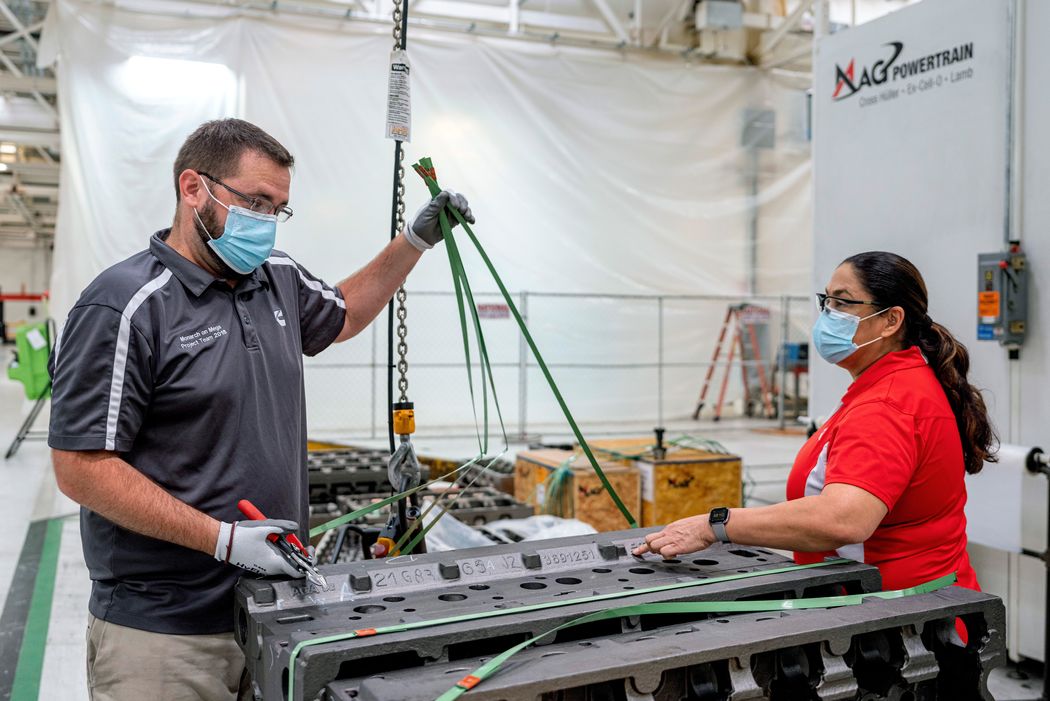By John McCormick and Paul Overberg | Photographs by Maxine Wallace for The Wall Street Journal
Aug. 13, 2021 9:09 am ET
One in seven residents in Columbus, Ind., a city of about 50,000, was born outside the United States. Public school students collectively speak more than 50 languages and dialects at home. Roughly three dozen foreign companies operate in the area.
A 45-minute drive south of Indianapolis, the manufacturing and transportation hub set in the middle of sprawling farmland is emblematic of how the nation’s growing ethnic and racial diversity, building for decades in coastal cities and other immigration hubs, is gaining in new areas across the U.S.
The first detailed data released from the 2020 Census on Thursday showed that the non-Hispanic white population declined for the first time in the nation’s history as growing numbers of Hispanics and Asians pushed the share of residents who identify as a minority to roughly four out of every 10 people.
Those changes are most apparent in pockets of the Midwest and northern Great Plains, which diversified at a faster rate than the rest of the nation during the past decade, a Wall Street Journal analysis of the new census data shows.
Percentage change in diversity from 2010-2020, based on diversity index

Note: The diversity index measures the probability that two randomly chosen people are different, using the current federal racial and ethnicity classifications. It varies from 0—where everyone in an area is from the same group—to approach 100—when all groups are equally present. A 55 score represents a 55% chance that the two people have a different race and ethnicity.
Source: WSJ analysis of U.S. Census Bureau data
The Journal calculated a diversity index for each of the nation’s more than 3,000 counties using a standard statistical method deployed by social scientists, with a score that measures the chance two randomly selected people in an area have different races and ethnicities.
Nationwide, the diversity index rose 22% during the past decade. Bartholomew County, which includes Columbus, recorded a 67% gain and was among the fastest in the nation to diversify.
The county, which saw its share of non-Hispanic whites drop to 78% from 87% a decade ago, now has diversity levels rivaling those in suburban areas of large metropolitan areas such as Boston, Chicago, Philadelphia and Denver, the Journal’s analysis shows, though nowhere near the levels in their central districts.
Jobs in agriculture, meat processing, manufacturing and other sectors—as well as a lower cost of living than in many larger metropolitan areas—are attracting immigrants to middle America.
The political influence of these newer arrivals could grow in the coming decades as more immigrants become voting citizens. For now, these trends generally favor Democrats.
Nonwhites backed President Biden in November, with exit polls showing the Democrat winning the support of 87% of Blacks, 65% of Latinos and 61% of Asians. Former President Donald Trump improved his standing slightly with Latinos, boosting his share to 32% in 2020 from 28% in 2016.
Across the Midwest, other clusters of counties with rapid recent diversity growth can be found along major highways or near areas with strong employment growth. Some counties in western North Dakota, where fracking for oil and gas have boosted jobs, saw their diversity index scores more than double during the past decade.
In Indiana, other south-central counties connected to Interstate Highway 65 like Bartholomew also recorded significant gains in diversity, including nearby Brown and Decatur counties. The road, Indiana’s primary north-south freight and passenger corridor, links Louisville and Chicago and connects older manufacturing areas around the Great Lakes with newer ones in more southern states, and serves as a catalyst for warehousing and manufacturing jobs.
Much of Bartholomew County’s diversification has been driven by engine manufacturing giant Cummins Inc., the top employer here. As the company recruited global talent to a place encircled by corn and soybean fields, other companies followed.
Efforts to create a diverse workforce at Cummins started more than a half-century ago when J. Irwin Miller, then the company’s chairman, began actively recruiting, hiring and promoting Black workers. Mr. Miller, who was among the organizers of the 1963 March on Washington led by Martin Luther King Jr. , saw the initiative as crucial to Cummins’ ability to broaden its talent pool.
That thinking later became an effort that encouraged the hiring of immigrants, including engineers from India and elsewhere in Asia.
Jennifer Rumsey, a Columbus native who is president and chief operating officer for Cummins, said the city is much more diverse than when she was growing up and that her company has worked with government and nonprofit groups to try to make it a welcoming place.
“We continue to work on how do we make sure we’re hiring and attracting diverse talent and retaining them, and that work in the community is just a key piece because if you don’t have a community environment that people want to come and live in, they’re not going to come work for you and stay,” she said.
Fred Armstrong, who served as Columbus mayor from 1996 to 2011, said efforts to broaden the area’s economy after tough times in the 1980s further spurred the area’s diversity. City and economic development officials made annual trips to Asia to pitch the community’s workforce while offering economic incentives to move production to the area.
The efforts paid off and now more than 30 international companies from countries such as Japan, China, India, Germany and Canada have located operating facilities in the community, according to the Columbus Area Multi-Ethnic Organization. Those companies include Faurecia Clean Mobility, NTN Driveshaft and Toyota Material Handling.
After losing population in the 1980s, Bartholomew grew in the 1990s and has continued to do so. The county also recorded one of Indiana’s larger percentage gains in population during the past decade outside the Indianapolis metropolitan area.
Census Bureau estimates not included in Thursday’s decennial release show about one in 10 of the county’s residents is foreign-born, with roughly 18% of that group being citizens. Some of those who work for Cummins and other employers in the area do so on temporary visas and green cards.
Among the foreign-born in the county, 57% are from Asia. About one person in eight speaks a language other than English at home.
The mix of cultures now present has seeped into many facets of daily life. Numerous ethnic restaurants dot the streets, international specialty food items are stocked by many groceries and home-improvement retailers label some items in both English and Spanish. The high school attended by former Vice President Mike Pence, who grew up here, is almost a third nonwhite.
The county’s public library has more than 3,700 non-English books, including titles in Chinese, French, Spanish, Japanese, Russian and three Indian languages (Hindi, Marathi and Tamil). There are also more than 800 non-English digital magazines and more than 1,400 ebooks.
In 2019, Columbus elected a majority Democratic city council for the first time in close to four decades. That same city council earlier this year passed an ordinance adding Diwali, the Indian festival of lights, to the list of dates when fireworks can be lighted by residents.
Mr. Sahajwala, president of the Indian Association of Columbus and a salesman for an information technology company, had since 2014 visited Columbus and the Midwest roughly a half dozen times a year from his previous home in Delhi. His wife, a recruiter for another IT firm, also made the move.
Leo Portaluppi, an Argentina-born president of a car dealership chain in Columbus, said about 20% of his sales staff can speak Spanish. He moved to the area close to a decade ago after living in a less-diverse Kentucky county.
“My kids felt different there,” he said. “Here they can see others like themselves.”
Still, there have been some tensions in the community. After the pandemic began unfolding, Tom Linebarger, chairman and chief executive for Cummins, heard that workers of Asian descent said they were concerned about heated rhetoric in the U.S. surrounding the origin of Covid-19 in China.
Nobody points to any threatening incidents in Columbus, but Mr. Linebarger said Asian employees expressed concern about visiting public places and had stopped taking their children outside for walks. “They were fearful,” he said.
In March, he wrote a memo to the company’s roughly 60,000 global employees addressing the issue head on.
“We need to be clear; Asian Americans, Chinese expatriates working in the U.S., or for that matter, any other member of our communities of Asian descent, had nothing to do with the COVID-19 pandemic,” he wrote. “We must do our part to speak out against these false associations and against acts of aggression and violence.”
Miguel Aranda and his wife, Luz Elena Michel, were drawn to Columbus by Cummins. Mr. Aranda, a mechanical engineer who also has an M.B.A., started working for the company in his native Mexico shortly after finishing college and moved to Indiana in 2009 following a stop at another company facility in North Carolina.
He described his residential neighborhood on the west side of town as a sort of international melting pot, where the smells and sounds of different cultures often fill the air. “People are used to accents here because their brains are used to it,” he said.
Elaine Hilber, a 35-year-old Democrat who in 2015 became the first Asian elected to the Columbus City Council, said there was more racism in the city when she was growing up. The daughter of Taiwanese immigrants whose mother worked for Cummins, Ms. Hilber said there were only about five other Chinese families then, a number she now estimates at 100.
“It makes your life really rich because of the diversity we have here,” said Ms. Hilber, who is one of two nonwhites on the seven-member city council.
Some longtime residents say they are concerned that the influx of newcomers includes people who entered the country unlawfully, although there’s no reliable data to measure that for a county as small as Bartholomew.
Columbus resident Lawrence Dale, who is retired after serving 20 years in the U.S. Marine Corps, said he supports Mr. Trump’s goal of building a wall along the southern border with Mexico because he believes there are too many immigrants in his city who have entered the U.S. illegally. “As long as it’s done legally, I don’t have a problem with it,” he said of immigration.
Whitney Amuchastegui, executive director of a local nonprofit called Su Casa, which seeks to boost Latino health, economic independence, education and safety, said Latinos sometimes have to endure “bigoted, crude comments in the grocery line.”
“Indiana is a state built on small, insular communities,” she said. “There’s an underlying culture that has strong fears and concerns about immigration and that leads to racism.”
Buoyed by strong wages among manufacturers like Cummins, which employs about 9,000 in the county, Bartholomew’s proportion of residents living below the poverty level is lower than the statewide average. The county’s median household income, $72,555, is about 25% higher than Indiana’s average.
Cindy Frey, president of the Columbus Area Chamber of Commerce, said recruitment of companies from outside the U.S. to the area has become easier over the years because of the growing diversity.
“It’s been a snowball effect,” she said. “The more diversity you have in your community, the easier it is to sell global companies.”

